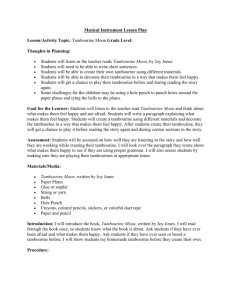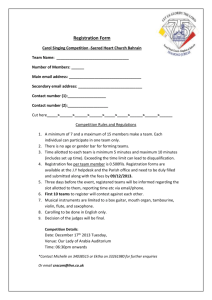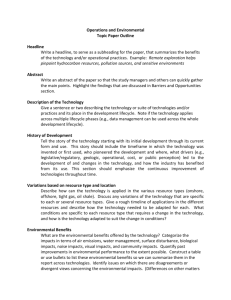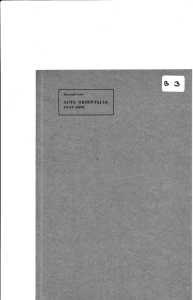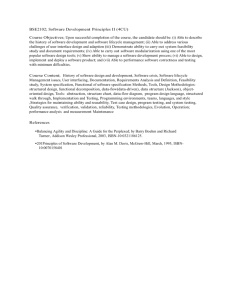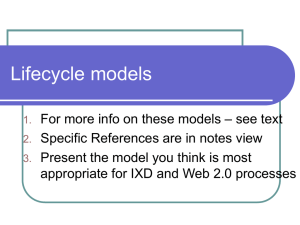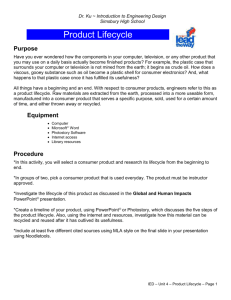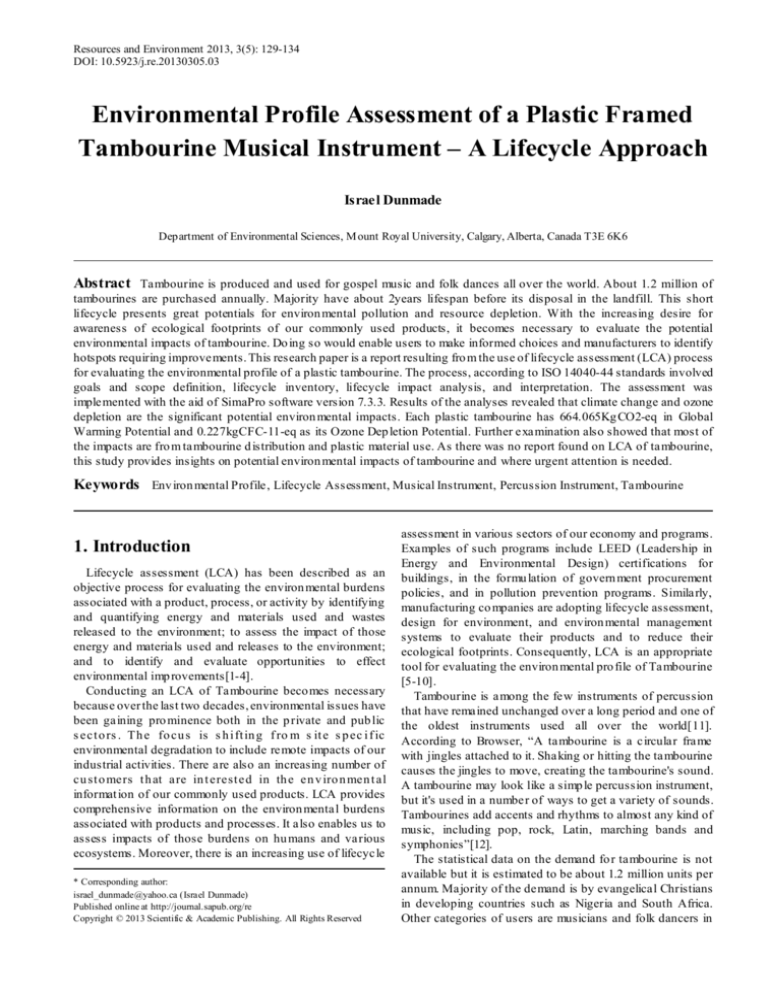
Resources and Environment 2013, 3(5): 129-134
DOI: 10.5923/j.re.20130305.03
Environmental Profile Assessment of a Plastic Framed
Tambourine Musical Instrument – A Lifecycle Approach
Israel Dunmade
Department of Environmental Sciences, M ount Royal University, Calgary, Alberta, Canada T3E 6K6
Abstract Tambourine is produced and used for gospel music and folk dances all over the world. About 1.2 million of
tambourines are purchased annually. Majority have about 2years lifespan before its disposal in the landfill. This short
lifecycle presents great potentials for environ mental pollution and resource depletion. With the increasing desire for
awareness of ecological footprints of our commonly used products, it becomes necessary to evaluate the potential
environmental impacts of tambourine. Do ing so would enable users to make informed choices and manufacturers to identify
hotspots requiring improvements. This research paper is a report resulting fro m the use of lifecycle assessment (LCA) process
for evaluating the environmental profile of a plastic tambourine. The process, according to ISO 14040-44 standards involved
goals and scope definition, lifecycle inventory, lifecycle impact analysis, and interpretation. The assessment was
implemented with the aid of SimaPro software version 7.3.3. Results of the analyses revealed that climate change and ozone
depletion are the significant potential environ mental impacts. Each plastic tambourine has 664.065Kg CO2-eq in Global
Warming Potential and 0.227kgCFC-11-eq as its Ozone Dep letion Potential. Further examination also showed that most of
the impacts are fro m tambourine d istribution and plastic material use. As there was no report found on LCA of tambourine,
this study provides insights on potential environ mental impacts of tambourine and where urgent attention is needed.
Keywords Env iron mental Profile, Lifecycle Assessment, Musical Instrument, Percussion Instrument, Tambourine
1. Introduction
Lifecycle assessment (LCA) has been described as an
objective process for evaluating the environ mental burdens
associated with a product, process, or activity by identifying
and quantifying energy and materials used and wastes
released to the environment; to assess the impact of those
energy and materials used and releases to the environment;
and to identify and evaluate opportunities to effect
environmental imp rovements[1-4].
Conducting an LCA of Tambourine beco mes necessary
because over the last two decades, environmental issues have
been gaining pro minence both in the p rivate and pub lic
s ect o rs . Th e fo cu s is s h i ft in g f ro m s it e s p ec i f ic
environmental degradation to include remote impacts of our
industrial activities. There are also an increasing number of
cu st o mers t h at are in t erest ed in th e en v iro n men t al
informat ion of our commonly used products. LCA provides
comprehensive information on the environ mental burdens
associated with products and processes. It also enables us to
assess impacts of those burdens on hu mans and various
ecosystems. Moreover, there is an increasing use of lifecycle
* Corresponding author:
israel_dunmade@yahoo.ca (Israel Dunmade)
Published online at http://journal.sapub.org/re
Copyright © 2013 Scientific & Academic Publishing. All Rights Reserved
assessment in various sectors of our economy and programs.
Examples of such programs include LEED (Leadership in
Energy and Environmental Design) certifications for
buildings, in the formu lation of govern ment procurement
policies, and in pollution prevention programs. Similarly,
manufacturing co mpanies are adopting lifecycle assessment,
design for environment, and environ mental management
systems to evaluate their products and to reduce their
ecological footprints. Consequently, LCA is an appropriate
tool for evaluating the environ mental pro file of Tambourine
[5-10].
Tambourine is among the few instruments of percussion
that have remained unchanged over a long period and one of
the oldest instruments used all over the world[11].
According to Browser, “A tambourine is a circular frame
with jingles attached to it. Shaking or hitting the tambourine
causes the jingles to move, creating the tambourine's sound.
A tambourine may look like a simp le percussion instrument,
but it's used in a number of ways to get a variety of sounds.
Tambourines add accents and rhythms to almost any kind of
music, including pop, rock, Latin, marching bands and
symphonies”[12].
The statistical data on the demand fo r tambourine is not
available but it is estimated to be about 1.2 million units per
annum. Majority of the demand is by evangelical Christians
in developing countries such as Nigeria and South Africa.
Other categories of users are musicians and folk dancers in
130
Israel Dunmade et al.: Environmental Profile Assessment of a Plastic Framed
Tambourine M usical Instrument – A Lifecycle Approach
the Middle East countries. The lifet ime use of a typical
plastic tambourine is about 3 years. Tambourines that are
used by hitting one of its ends against the other hand usually
have a shorter utilization lifespan. The reason is because
such tambourine’s frame usually fracture or break at so me
joint between the handle and the adjoining side that hits the
other hand. When the failure occurs, the user has no choice
but to purchase another one. Investigations revealed that
plastic tambourine are not repaired but they are simp ly
tossed into a landfill. With such a short utilization lifespan
and looking at the big picture, it becomes necessary to
evaluate the environmental imp licat ions of the cycle of
resource extraction, manufacture, use and landfilling of
damaged tambourine. The potential environmental impacts
of the plastic tambourine were evaluated by using LCA
process as stipulated in ISO 14040 series. The
implementation of the LCA process is described in section 2.
Results of the analysis are d iscussed in section 3. The paper
was ended with the conclusions drawn from the results of the
analysis.
2. Methodology
Fig. 1 is a diagrammat ic illustration of the LCA process.
The process involves defining the goals and the scope of
analysis, preparing a lifecycle inventory of the product data,
analyzing the potential lifecycle hu man and environmental
impacts, and interpretation of the results of the analysis
[1],[2],[13].
Figure 1. Lifecycle Assessment Process
2.1.1. Object ives of the Study
The goal of this LCA was to determine the potential
environmental impacts of a plastic tambourine to which
LCAs’ of other types and processes of making tambourine
can be compared. Understanding the ecological footprints of
the tambourine would p rovide an insight into its inherent
sustainability. Informat ion fro m this LCA would be useful in
identifying the hot spots in the manufacturing process.
Tambourine manufacturers would find th is information
useful for further technological advancement of their
tambourine. It will also help them in identifying where and
how to reduce overall resource use and environmental
impact of their tambourine and/or its production process.
Moreover, it would help environmental conscious
tambourine users (the public) to make informed choices.
2.1.2. Scope Definit ion
2.1. Goal and Scope Definition
This is the first stage of the LCA process. Reasons for the
study, intended audience and the scope of the study that is
necessary for the achievement of the goals are determined at
this stage.
The scope of this LCA study is cradle to grave. It involved
all the processes from ext raction of materials to the disposal
of the plastic tambourine. The system boundary is illustrated
with Fig. 2. The functional unit for the LCA analysis is a
221 /2 cm diameter half-moon black plastic “Rocker ™”
tambourine that could make varieties of “metallic ting ling”
sound. The product is 289.4 g by mass.
Figure 2. System boundaries of tambourine’s lifecycle
Resources and Environment 2013, 3(5): 129-134
2.1.3. System Boundaries
131
software.
Investigations revealed that the model of p lastic
tambourine is manufactured in Jiangsu, China. It is shipped
to a distributor in Toronto from where batches are sent to
retail outlets all over Canada. The sample used in this
analysis was purchased in Calgary. It was used for about two
and half years before it fractured and became unusable. The
black plastic tambourine has 32 jingles arranged in two rows
of eight gangs. In the laboratory, the whole assembly was
weighed, disassembled, and its various component parts
were weighed to obtain the mass value. In addition,
measurements of the dimensions of the tambourine, the slots,
pins, and fasteners were taken. Investigations were carried
out on the manufacturing, distribution, use and end-of-life
management of the product. Investigations revealed that
ABS plastic material was used to manufacture the plastic
frame by injection moulding. This is followed by cutting
slots for the jingles on the plastic frame. The spacing of two
row jingles is about 0.5cm. The nu mber of cuts on each row
varies but for this tambourine there were 16 cuts with eight
cuts on each row. Stainless steel is the material used for
making the jingles for this tambourine. Each jingle which is
3.7cm in diameter has a 6mm d iameter hole and was pressed
to shape. The jingles are paired for each slot. In addition, two
pairs of jingles are loosely pegged in the plastic frame by a
4.5cm long stainless steel pin. Experience shows that these
pins thin down and break during use. Pin breakage often
serves as the onset of deterioration for tambourines as it
results in the loss of jingles. This is then followed by
eventual fracture of the plastic frame which marks the end of
useful life for tambourines. Bro ken tambourine are not
repaired nor disassembled for reuse. They are generally
tossed into a landfill.
2.2. Lifecycle Inventory
Lifecycle inventory is the second stage in the LCA process.
It involves compilation and quantification of the product data
for the third stage of LCA. Data used in this report was
collected through measurement, desktop research, and
interviews with a retailer. All attempts were made to collect
and use the most up-to-date primary data available. Ho wever,
secondary data from databases such as Ecoinvent databases
as well as data from reports were chosen where primary data
was not available. The data collected was entered into
SimaPro LCA software. Tab le 1 is an ext ract of major
lifecycle inventory outcome of the data entered in the
Table 1. An extract of the lifecycle inventory of Tambourine
Substances
Unit
Amount
Ammonia
kg
0.000157394
Ammonium, ion
kg
0.000337533
BOD5, Biological Oxygen Demand
kg
0.00435701
Calcite, in ground
kg
0.525261721
Calcium, ion
kg
0.003696205
Carbon dioxide
kg
9.334394219
Carbon monoxide
kg
0.026072052
COD, Chemical Oxygen Demand
kg
0.018066889
DOC, Dissolved Organic Carbon
kg
0.014386298
Energy, from coal
MJ
67.77221516
Methane
kg
0.004357587
Methane, bromotrifluoro-, Halon
1301
kg
0.01813828
Methane, dichloro-, HCC-30
kg
0.027361834
Methane, tetrafluoro-, CFC-14
kg
0.055183195
2.2.1. Limitations, Assumptions and Exceptions
Energy consumption for the product manufacture and
packaging used for the transportation were not included in
the analysis because the data was not available.
2.2.2. Relating the Data to the System
The analysis was based on one unit of half-moon shape
plastic tambourine of 221 /2 cm in diameter and 289.4g by
mass. All co llated data were processed in relation to the
product.
2.3. Lifecycle Impact Assessment
The lifecycle inventory data was classified into various
impact categories such as climate change, ozone depletion,
land use, ecotoxicity, acidification, and others. Table 2 and
Fig. 3 show the results of characterizat ion of relevant data in
each impact category while Fig. 4 shows the potential
impacts of tambourine on human health, ecosystems and
resources.
Table 2. The Plastic Tambourine’s Lifecycle Impact Analysis Results
GWP
ODP
POCP
AP
EP
kg CO2 -eq
kg CFC-11-eq
kg C2H4-eq
kg SO2 -eq
Max kg O2-eq
664.06522
0.226728502
0.00107905
0.1064355
0.176229725
GWP Global Warming Potential
ODP Ozone Depletion Potential
POCP Photochemical Ozone Creation Potential
AP Acidification Potential
EP Eutrophication Potential
132
Israel Dunmade et al.: Environmental Profile Assessment of a Plastic Framed
Tambourine M usical Instrument – A Lifecycle Approach
Figure 3. Lifecycle Impact Analysis of T ambourine
Figure 4. Lifecycle Impact Analysis of T ambourine _ Damage Assessment
Resources and Environment 2013, 3(5): 129-134
2.4. Interpretation
This is the last stage of the LCA process. It consists of the
identification of significant issues, evaluation of the LCA
data and process, and conclusions fro m the results.
2.4.1. Identification of Significant Environ mental Issues
The purpose of this step was to identify input and output
data from the inventory table and impact analysis results that
represent the most important results of the study in relation to
the goal and scope definition. Two co mmonly used
approaches for this purpose are the contribution analysis and
anomaly assessment. In this study, comparative contribution
of various substances and impact categories in the results
were examined to determine their significance. A look at the
lifecycle inventory data revealed that environmental releases
of heat and carbon dioxide are the significant environ mental
issues. The lifecycle inventory also showed that there were
significant amounts of rocks and gravel disturbance as well
as environmental releases of Styrene and Phenol. Moreover,
an examination of the lifecycle impact analysis results
revealed that global warming is the greatest potential
environmental impact of the p lastic tambourine. Other t wo
potential environmental impacts of note are o zone depletion
potential and eutrophication potential. A crit ical look at the
various stages of the tambourine lifecycle shows that the
most significant impact is fro m tambourine distribution and
the plastic material use.
2.4.2. Evaluation
The data and processes selection as well as consistency
with regard to the methodology of the study was examined at
this stage of the LCA process. The aim was to establish
confidence in the result of the study, based on the preceding
stages of the LCA, especially in relat ion to the goal and
scope of the LCA study. The evaluation revealed that the
process used was consistent with the ISO 14040s standards
and the results would be reliable.
have been used for further imp rovement of the standard of
liv ing of the populace and community infrastructure would
have to be diverted to remedy various problems caused by
these impact. Thus, social, economic and environ mental
sustainability would be affected both at the micro- and
macro- levels.
4. Conclusions
This study provided an insight on the potential
environmental impacts of Tambourine. It shows that a
product though simp le in configuration can have debilitating
impacts on human health and ecosystem welfare. Results
fro m this study showed that distribution is the lifecycle stage
that contributed most significantly to the ecological footprint
of the tambourine. The d istribution system, which has to do
with the transportation of the product to clients, would
require re-consideration in order to reduce its potential
impacts on the environment. The sourcing of the product
nearby, fro m a Canadian manufacturer, would therefore be
necessary for significant reduction in the impacts.
Further study would be necessary to compare tambourine
made fro m wooden frame and other materials with the result
of this study so that consumers can choose a mo re
environmental friendly tambourine model. Availability or
encouragement of a take-back p rogram, d isassembly and
reuse of tambourine co mponent parts such as the jingles,
screws and pins would also reduce its potential
environmental impacts. In addition, conducting a lifecycle
costing and social lifecycle assessment study on the product
would be necessary to provide a balanced view of the
economic and socio-cultural aspects of the product.
REFERENCES
[1]
A. Jensen, L. Hoffman, B. M øller, A. Schmidt, K.
Christiansen, J. Elkington and F. van Dijk, “Life-cycle
assessment (LCA) – a guide to approaches, experiences and
information sources,” Environmental Issues Series No 6.
European Environment Agency, 1997.
[2]
I. Dunmade, “Recycle or Dispose Off? Lifecycle
Environmental Sustainability Assessment of Paint Recycling
Process,” Resources and Environment, vol. 2, no. 6, pp.
291-296, 2012.
[3]
B. G. Jeroen (Ed), Handbook for Life Cycle Assessment.
Operational Guide to the ISO Standards, Series:
Eco-Efficiency in Industry and Science, vol. 7, 708p, 2002.
[4]
A.M . Al-Salem and P. Lettieri, “ Lifecycle Assessment (LCA)
of M unicipal Solid Waste M anagement in the State of Kuwai,”
European Journal of Scientific Research, vol. 34, no. 3, pp.
395-405, 2009.
[5]
Baitz, M ; Kreissig, J.; Byme, E.; M akishi, C.; Bey, N.;
Hansen, M .; Hansen, A.; Bosch, T.; Borghi, V.; Watson, J.
and M iranda, M . (2004). Life Cycle Assessment of PVC and
3. Results and Discussion
A look at the result of the analysis shown in Table 1 and 2
revealed that the lifecycle energy consumption for each
tambourine is 67.8MJ. Currently the main source of the
energy is coal. Moreover, carbon dioxide emission is the
main environ mental burden fro m the plastic tambourine. In
addition, the study revealed that the greatest potential
environmental impact of tambourine is the possibility to
affect climate change. It can also cause ozone depletion
which may lead to skin cancer. Other potential impacts are
acid rain that could result in soil degradation and water
contamination. It could also cause some damage to the
aquatic lives. Consequences of all these impacts would not
be limited to negative effects on human health and
ecosystem welfare but it would also affect food and other
resource availability. Furthermore, resources that would
133
134
Israel Dunmade et al.: Environmental Profile Assessment of a Plastic Framed
Tambourine M usical Instrument – A Lifecycle Approach
of principal competing materials. Retrieved from
ec.europa.eu/enterprise/sectors/chemicals/.../pvc-final_repor
t_lca_en.pdf
[6]
[7]
I.S. Dunmade, “Collaborative lifecycle design A viable
approach to sustainable rural technology development,”
International Journal of Technology M anagement and
Sustainable Development, vol. 9, no. 2, pp.149-158,
November 2010.
I.S. Dunmade, “The Use of Life Cycle M anagement
Principles in Biosystems Engineering: A Pragmatic Approach
to Solving A gri-industrial Sustainability Problems,” Journal
of Agricultural Science and Technology A, vol. 2, pp.
357-362, 2012. Available: http://www.davidpublishing.com/
davidpublishing/Upfile/5/3/2012/2012050310503456.pdf
[8]
I.S. Dunmade, “Development of system models for industrial
processes selection with regard to product lifecycle extension
(PLETS models); Berlin: Logos Verlag, 2001, ch. 1.
[9]
W. Klöpffer, “ Life Cycle Sustainability Assessment of
Products. The International Journal of Life Cycle
Assessment,” vol. 13, no. 2, pp. 89-95, 2008.
[10] W. Klöpffer, “ Life-Cycle Based M ethods for Sustainable
Product Development (With comments by Helias A. Udo de
Haes),” The International Journal of Life Cycle Assessment,
vol. 8, no. 3, pp. 157-159, 2003.
[11] J. Blades, Percussion Instruments and their history; London:
Bold Strumme, 1992, ch. 4.
[12] C. Browser, “Ways to Use a Tambourine,” 2013. Available:
http://entertainmentguide.local.com/5-ways-use-tambourine10511.html
[13] O. Jolliet, R. M üller-Wenk, J. Bare, A. Brent, M . Goedkoop,
R. Heijungs, N. Itsubo, C. Pena, D. Pennington, J. Potting, G.
Rebitzer, M . Stewart, H.A. Udo de Haes, and B. Weidema,
“The LCIA M id-point damage Framework of the
UNEP/SETAC Life Cycle Initiative,” International Journal of
Life Cycle Assessment, vol. 9, no. 6, pp. 394-404, 2004.

